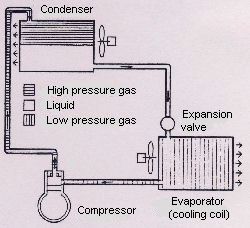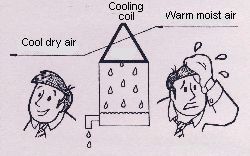|
Compressor Location
The correct location of the unit is important for two reasons.
- Noise. The unit makes noise, although some types are quieter than others. The compressor should be screened with a fence and/or landscaping so it will not disturb the neighbours..
- Heat. Unit should be installed in the coolest location or on the north side. The cooler the air entering the condenser, the more efficient it is.
Sizing of Equipment
Equipment should be selected so that its cooling capacity will be matched to the calculated heat gain of the house.
Unlike heating systems, cooling systems should not be oversized. This is because a major benefit of cooling is dehumidification. In order to dehumidify the air passing over it, the evaporator must be kept cold, which means the compressor should run almost continuously for maximum comfort. |
|
|
.
...
.
| Condensate pump. Sometimes it is not practical to run the condensate line directly to a floor drain. In that case a pump is required to detour the discharge to a suitable drain which in most cases is the laundry tub. |
|
Central Air Conditioning
How It Works.
Condensate tray, line, pump.
|
|
| . |
Need more information? Use our search box
How It Works
Air conditioners lower the air temperature which causes water in the air to condense. We can observe this process on a glass of ice water. The ice water lowers the air temperature around the glass and condenses it into water drops on the glass surface. Air conditioners lower the humidity levels and make the house more comfortable to live in.
Evaporator or cooling coil. This coil is located in the supply plenum of the furnace (burner side). At this point room air is conditioned. The evaporator does two things:
- It chills the air for cooling the house.
- It removes moisture from the air and thereby lowers the humidity levels. The water (or condensate) is drained into a floor drain or laundry tub. The heat is absorbed by a cold gas or refrigerant. This low pressure gas is removed from the evaporator coil by the ...............
Compressor which then increases the pressure before sending it on to the .........
Condenser. The condenser removes the heat from the compressed gas and expels it to the outdoors. The cooled gas becomes a liquid and on its way back to the evaporator coil the liquid goes through an ..
Expansion valve where the pressure is reduced and where it changes back to a cold gas as it re-enters the evaporator coil and the process repeats itself.
Frost build-up. If the cooling or coil temperature falls below 0 degrees C (32 degrees F), ice will form. The system should be turned off to prevent equipment damage. |

 |
Frost build-up can be caused by one or more of the following conditions.
Inadequate air flow of the system caused by:
- Bedroom doors not undercut by 3/4" (19 mm). (1" or 25 mm. for heat pumps)
- Slipping or broken blower fan belt.
- Clogged furnace filters.
- Open or missing damper on by-pass humidifier duct.
- Leak in the system, low on refrigerants.
- 'Air tight' furnace room. (install vents in surrounding walls and/or louvered doors)
Condensate Tray, Line, Pump
The tray is located underneath the evaporator or cooling coil in the furnace. It should be checked occasionally for leaks. A leaking or overflowing tray could do serious damage to the furnace heat exchanger.
Condensate line.
This line runs from the condensate tray to the floor drain. It should not be discharged into a sanitary plumbing vent or stack to prevent sewer gases from being drawn into the house. If it is discharged this way, the line should have a trap. No discharge usually means a plugged line which could lead to an overflowing tray, see above.
|
| ... |
|
|
| ... |
| Back to Top |
|
|